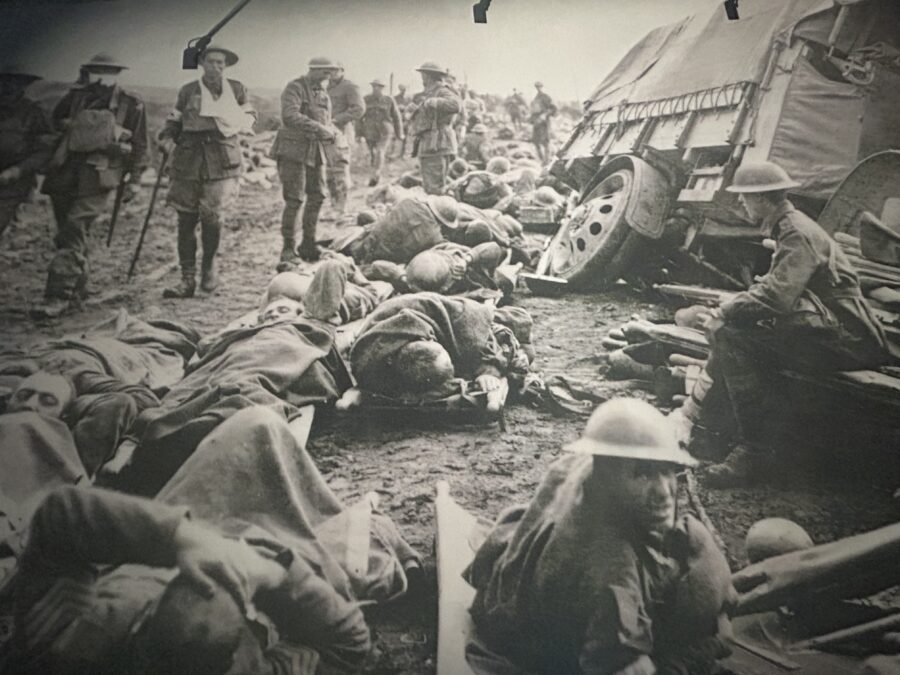
Kieran’s Our City, Our Town Article,
Cork Independent, 13 March 2025
Making an Irish Free State City – The Munster Cross at Ieper
In April 1924, the Cork Legion of Ex-Servicemen, through large scale funding, erected a 20 feet high memorial Cross at Ypres/Ieper in Belgium. The Munster Memorial had its origins in a decision taken by the Cork Legion early in 1924 to erect a suitable memorial in Flanders in memory of the comrades from Munster whom sacrificed their lives fighting to liberate Belgium from German occupation. The person chosen to design and manufacture the memorial was John A O’Connell, a well-known Cork sculptor, who had his studio in Cork City.
A memorial committee was also formed to raise funds for the memorial and oversee its erection, and among its patrons was William F O’Connor, a former Lord Mayor of Cork, Richard Beamish, the High Sherrif of Cork, Field Marshal Haig, and General William Hickey, the former commander of the 16th (Irish) Division.
While the necessary funds were being raised and the memorial was being designed and manufactured a suitable location for it to be erected in Flanders had to be found. To facilitate this, the committee contacted members of the Ieper League in the city and they in turn spoke to the Burgomeister (town Mayor) and members of Ieper City Council.
During these discussions the Ieper City Council suggested that the memorial be erected near the ruins of The Cloth Hall and St Martin’s Cathedral and this was accepted. On 1 July 1924 the Irish newspapers reported that “The Burgomeister sent a message to the Secretary of the Memorial Committee, stating that that the city of Ypres [Ieper] is proud at having been chosen as the site for the memorial”.
The Cork Examiner records that on 5 July 1924, around one hundred of Irish veterans of the First World War left Cork City bound for Ieper where they would attend the unveiling of an Irish memorial dedicated to the men of Munster who died fighting for freedom and visit other battlefield sites. Before leaving Ireland, they were joined by a large crowd of veterans from other parts of the country who were accompanied by members of their families.
On the morning of 7 July 1924, the Irish veterans arrived at Ieper train station for the dedication of the Munster Cross and they were met by the Burgomeister, members of Ieper City Council and many of the city’s citizens. Among those who attended the dedication were Count Gerald O’Kelly, the Irish Free State Representative in Belgium, members of the Belgium Government and Major-General Sir Bryan Mahon, former commander of the 10th (Irish) Division and a senator in the Irish Free State.
Mahon also thanked the Burgomaster and councillors for granting such a splendid site for the memorial stating:“Our honoured dead will rest at peace under the shadow of the new Cathedral, and within the ruins of the old”.
The Burgomeister also spoke saying that he recalled the sacrifices made by Irish soldiers to save his country and congratulated the Irish people on attaining their long-fought-for freedom.
After the speeches, wreaths, including many from Cork, were laid at the plinth and after the ceremony a deputation visited the grave of Willie Redmond MP at Locre. The Irish veterans went on to visit many of the battlefields of the First World War and they returned to Ireland on 11 July.
The inscription on the Munster Cross is in English, Irish and French. It reads: “In memory of Those men of Munster who died fighting for freedom, A tribute Erected by the people of the Province And Cork its capital City”.
Immediately under the shaft of the Cross are richly wrought symbols – on one of which are the Three Crowns, the Arms of Munster. The Cross proper is an imposing monolith, 11 feet high, the shaft being divided into panels filled with interlaced carving, and the ancient “Trumpet” pattern. On the centre of the Arms is a raised monogram of the Redeemer, and the Arms themselves are richly and boldly decorated.
Two additional historic connections between our Cork and Ieper are in the fact that Lieutenant Colonel James Lee, a graduate of the North Monastery School in Cork, was the town Mayor of Ieper from April 1916 to April 1918. In addition to that, a substantial amount of the funding for the cross was provided by the people of Cork.
Followed delegation visits in 2008 and 2015 by former Lord Mayors Cllr Brian Birmingham and Cllr Tony Fitzgerald, it came to the attention of Cork City Council that the Munster Cross was in a state of disrepair. A project team from Cork City Council were sent on a site visit to assess the situation in Ieper. As a result of that, the Common Wealth Graves Commission completed repair works to the Munster Cross.
Last year, 2024, coincided with the centenary of the dedication of the Munster cross. New benches to sit upon and reflect upon were unveiled as a partnership project between Cork City Council and Ieper City Council. The benches are a quiet reflective space for visitors to the Cross to take time to remember those lost.
As Lord Mayor of Cork in April 2024 I visited the City of Ieper to thank the Mayor, Emily Talpe, Deputy Mayor, Dimitry Soenan and Chief Executive Steofan Depretere who were so positive and helpful in their response to Cork City Council’s conservation proposals for the Munster cross and associated bench projects. Cork historian Gerry White gave a brief history of the cross at the unveiling of the benches with support from Nuala Stewart, Corporate Affairs in Cork City Council. Dan Breen, curator of Cork Public Museum was a massive help at the time and helped with the research of this column.
To be continued…
Caption:
1295a. Gerry White, Historian with former Lord Mayor of Cork Cllr Kieran McCarthy & Dimitry Soenan, Deputy Mayor, Ieper, April 2024 (picture: Cork City Council).




